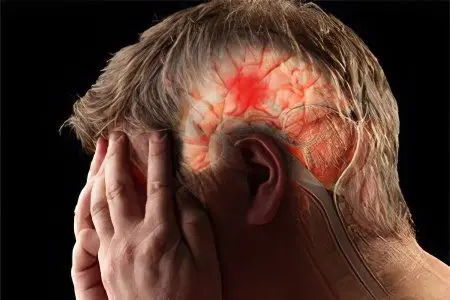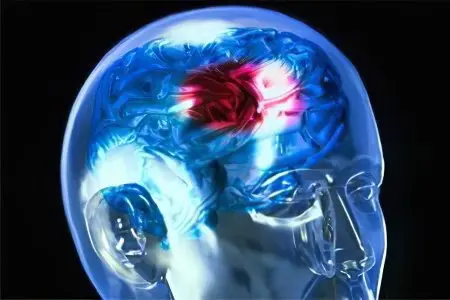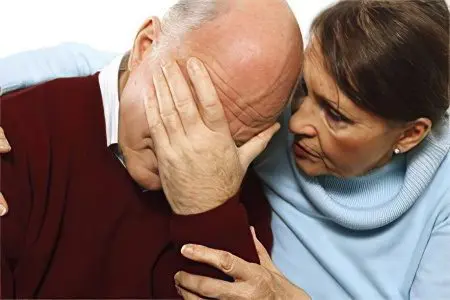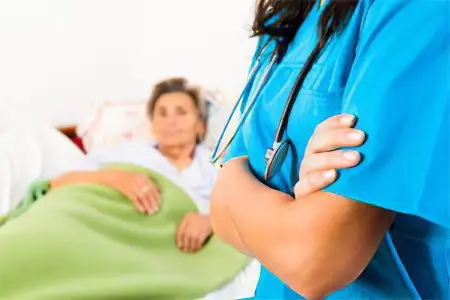Contents
Cerebral infarction is a clinical syndrome, which is expressed in an acute violation of local brain functions. It lasts more than 24 hours, or leads to the death of a person during this time. Acute circulatory disorders in cerebral infarction occur due to blockage of its arteries, which provokes the death of neurons in the area that feeds on these arteries.
A cerebral infarction is also called an ischemic stroke. This problem is very relevant in the modern world, since a huge number of people die every year due to cerebral infarction. Mortality in ischemic stroke is 25%, another 20% of patients die within a year, and 25% of the survivors remain disabled.
Symptoms of a cerebral infarction

The symptoms of a cerebral infarction depend on where the lesion is located.
However, there are common symptoms of this pathological process, including:
Headache;
Loss of consciousness, sometimes coma may develop;
Dizziness;
Violations of the functioning of the pelvic organs;
Pain in the eyeballs;
feeling of heat;
dry mouth;
Nausea and vomiting against the background of severe headache;
Seizures (not always present).
If the focus of cerebral infarction is localized in the right hemisphere, then the following clinical picture is characteristic:
Complete immobility (hemiparesis) or a significant decrease in strength (hemiplegia) of the left limbs;
Sensitivity in the left half of the body and face disappears or sharply decreases;
Speech disorders will be observed in left-handers. In right-handers, speech disorders develop exclusively with damage to the left hemisphere. The patient cannot reproduce words, but conscious gestures and facial expressions are preserved;
The face becomes asymmetric: the left corner of the mouth goes down, the nasolabial fold is smoothed out.
Depending on which half of the brain is damaged, the symptoms of a cerebral infarction will be observed on the opposite side. That is, if the lesion is located in the left hemisphere, then the right half of the body will suffer.
If a cerebral infarction develops in the vertebrobasilar vascular pool, then the patient’s symptoms are as follows:
Dizziness, which increases when the head is thrown back;
Coordination suffers, static disorders are observed;
There are violations of the movement of the eyeballs, vision deteriorates;
A person pronounces individual letters with difficulty;
There are problems with swallowing food;
Speech becomes quiet, hoarseness appears in the voice;
Paralysis, paresis, impaired sensitivity of the limbs will be observed from the side opposite to the lesion.
It is worth considering separately the symptoms of a cerebral infarction, depending on which particular cerebral artery is damaged:
Anterior cerebral artery – incomplete paralysis of the legs, the occurrence of grasping reflexes, eye movement disorders, motor aphasia;
Middle cerebral artery – incomplete paralysis and disorder of the sensitivity of the hands, as well as the lower half of the face, sensory and motor aphasia, laterofixation of the head;
Posterior cerebral artery – visual disturbances, the patient understands the speech of another person, he can speak himself, but he forgets most of the words.
In severe cases, depression of consciousness occurs and a person falls into a coma, which can occur with damage to any part of the brain.
Causes of cerebral infarction

There are the following causes of cerebral infarction:
Atherosclerosis. It develops in men earlier than in women, since at a young age female vessels are protected from atherosclerotic lesions by sex hormones. First of all, the coronary arteries are affected, then the carotid, and subsequently the blood supply system of the brain;
Hypertension. Enhances atherosclerosis and disrupts the adaptive reactions of the arteries mild hypertension (pressure up to 150/100 mm Hg), which is the most dangerous;
Heart diseases. So, people who have had a myocardial infarction have a high risk of developing a cerebral infarction. In 8% of patients after myocardial infarction, an ischemic stroke will develop within the first month, and in 25% of patients within six months. The danger is also coronary heart disease, heart failure;
High blood viscosity;
Atrial fibrillation arrhythmias. They are the reason that blood clots form in the left atrial appendage, which are subsequently transferred to the brain;
Violations in the work of the endocrine system, first of all, it is diabetes mellitus;
Vascular diseases (pathologies of their development, Takayasu’s disease, anemia, leukemia, malignant tumors).
In addition, do not forget about the risk factors that increase the likelihood of a cerebral infarction, among them:
Age (every ten years of life increases the risk of developing a cerebral infarction by 5-8 times);
Genetic predisposition;
Hypodynamia;
Excess weight;
Smoking (if this bad habit is supplemented by taking oral contraceptives, then smoking becomes a leading risk factor for developing cerebral infarction);
Alcohol abuse;
Acute stress, or prolonged psycho-emotional stress.
Sequelae of a cerebral infarction

The consequences of a cerebral infarction can be very serious and often pose a direct threat to human life, among them are:
Edema of the brain. It is this complication that develops more often than others and is the most common cause of death in the first week after an ischemic stroke;
Congestive pneumonia is the result of the patient being in a horizontal position for a long time. It develops most often 3-4 weeks after suffering a cerebral infarction;
Pulmonary embolism;
Acute heart failure;
Bedsores from lying in bed for a long time.
In addition to the listed consequences of cerebral infarction, which develop in the early stages, long-term complications can also be distinguished, including:
Violation of the motor function of the limbs;
Decreased sensation in the arms, legs, and face;
speech problems;
Deterioration of mental abilities;
Mental disorders;
Difficulty swallowing food;
Loss of coordination when walking, during turns;
Epileptic seizures (up to 10% of people who have had a cerebral infarction are susceptible to them);
Malfunctions of the pelvic organs (the bladder, kidneys, intestines, reproductive organs suffer).
How is a heart attack different from a stroke?
With a cerebral infarction, there is a violation of its blood supply, as a result of which the tissues of the affected area begin to die. Inadequate blood flow to the brain occurs due to atherosclerotic plaques that prevent its normal flow, due to heart rhythm disturbances, or due to problems with the blood coagulation system.
With a hemorrhagic stroke of the brain, on the contrary, the blood flow to it increases, which causes a rupture of the artery. The cause is vascular pathology or hypertensive crisis.
There are differences in the course of the disease. So, a cerebral infarction develops gradually, over several hours or even days, and a hemorrhagic stroke occurs almost instantly.
Treatment of cerebral infarction

Treatment of cerebral infarction is primarily based on thrombolytic therapy. It is important that the patient is admitted to the neurological department within the first three hours of the onset of an attack. It is necessary to transport the patient in an elevated position. The head should be 30°C higher than the body. If a thrombolytic is administered to the patient at the specified time, the drug will begin to dissolve the existing thrombus very quickly, which is most often the cause of impaired blood supply to the brain. The effect can often be seen almost instantly, in the first seconds of drug administration.
If thrombolytic therapy is not carried out in the first three hours from the onset of a cerebral infarction, then it no longer makes sense to carry it out further. There will be changes in the brain, the nature of which is irreversible.
It should be borne in mind that thrombolysis is performed only when the doctor has made sure that the patient has a cerebral infarction, and not a hemorrhagic stroke. In the latter case, such therapy will lead to death.
If it is not possible to administer a thrombolytic, then the following measures are indicated:
Decreased blood pressure;
Taking antiplatelet agents (Aspirin) or anticoagulants;
Reception of funds aimed at improving cerebral blood supply.
Also, patients are prescribed vitamins of group B, they carry out rehabilitation treatment, they are engaged in the prevention of bedsores.
Surgical treatment of cerebral infarction is surgical decompression aimed at reducing intracranial pressure. This method allows to reduce the percentage of mortality in cerebral infarction from 80% to 30%.
An important component of the general scheme for the treatment of cerebral infarction is competent restorative therapy, which is called “neurorehabilitation”.
You need to start it from the first days of the disease:
Movement disorders are corrected with the help of physiotherapy exercises, massage and physiotherapy methods. At the moment, there are special simulators that help people recover after a cerebral infarction;
Speech disorders are corrected during individual sessions with a speech therapist;
Swallowing dysfunctions are leveled by special devices that stimulate the work of the laryngeal and pharyngeal muscles;
Classes on the stabiloplatform help to cope with coordination problems;
Equally important is the psychological assistance to the sick. A psychotherapist helps to cope with emotional problems;
For life, a person is prescribed statins and Aspirin preparations;
To improve the functioning of the brain, it may be recommended to take medicines such as Cavinton, Tanakan, Bilobil, etc.
It is important for the patient himself to constantly monitor the level of blood pressure, blood sugar and cholesterol levels, as well as give up bad habits and lead a healthy lifestyle with the obligatory presence of moderate physical activity in it.









